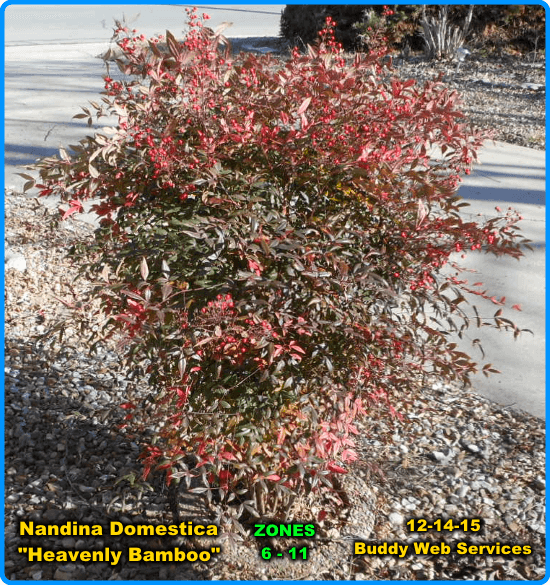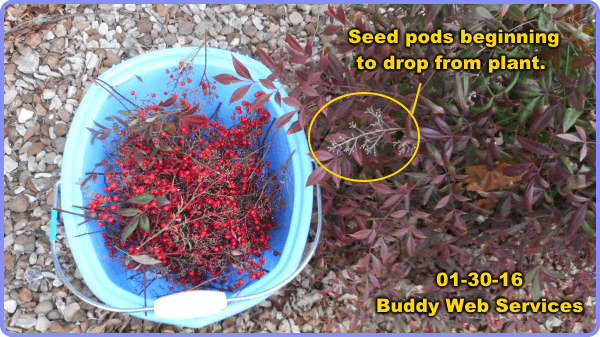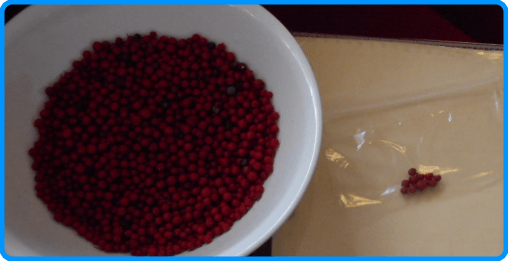Nandina Domestica aka “Heavenly Bamboo”
A beautiful shrub year round however the real showy display is during the fall and winter. Hardy in U.S. zones 6 thtough 11, Heavenly Bamboo is evergreen too.
Here is a photo from December 2015, located in Derby Kansas—

Nandina Domestica aka “Heavenly Bamboo”
Seed Pod Harvest is in January when pruning for plant health is recommended.

Nandina Domestica – Freshly Harvested Seed Pods available upon request.

When the seed pods begin to drop – harvest other pods to extract seeds.

Seed Pods – 2 seeds in each pod – Freshly Harvested Pods Available!
To acquire pods, freshly harvested in January 2016 please contact Eileen Brown through private message at Facebook.
Note — seeds pods turn black within a couple of weeks of harvesting. THIS is the natural progression of the pods.
This evergreen shrub is not a real bamboo plant. Nandina belongs to the barberry family, but resembles bamboo because of its jointed cane-like stems and lacy looking leaves. In U.S. Department of Agriculture plant hardiness zones 6 through 11, nandina is planted outside as showcase plants or hedges where new plants are needed to fill in the area.
Propagation is achieved by sucker division, stem cuttings and sowing seeds. Nandina is evergreen in designated zones.
Find more on Nandina at https://en.wikipedia.org/wiki/Nandina
How To Grow Nandina From Seed
Nandina thrives in hardiness zones 6 – 11. Find your hardiness zone at http://planthardiness.ars.usda.gov/PHZMWeb/#
- Locate a mature nandina plant from which to collect the seeds and wait until the fall when berries turn bright red in color. Pick the berries off the plant. Each berry contains two nandina seeds.
- Fill a small to medium-sized bowl half -full of lukewarm water and place the red berries into it. Set the bowl aside and allow the berries to soak for 24 hours, which softens the outer pulp. Note – pods or “berries” may turn black in a couple of weeks. This is the natural progression of the pods – Seeds will still be hardy when extracted from black pods. Longer soaking is required with black pods.
- Squeeze the berries using your fingers to scrape away the outer pulp and reveal the inner seeds. Scoop up the seeds, which float, from the top of the water and discard the pulp and water from the bowl.
- Fill 3- to 4-inch diameter plant pots with a sterile potting mix until it reaches 1/2 inch from the top rim of the pot. Poke a 3-inch deep hole in the center of the soil in each pot using a pencil.
- Insert one nandina seed into each hole and fill in the holes completely with additional soil mix.
- Place all of the pots into a shallow tray to make transporting them easier and to collect water drainage. Water the top of the soil in each pot until it soaks all the way to the bottom and drains out. Cover the tray with a piece of clear plastic wrap. Water the tray hereafter to keep soil moist.
- Place the pots in an area that maintains a consistent temperature of 69 degrees Fahrenheit or warmer and has bright sun exposure. If needed, place the tray on a heating mat to achieve the proper temperature.
- Wait until the seeds germinate in approximately 60 days and then remove the plastic wrap. Continue watering the seedlings throughout the winter and plant outdoors in the spring when frost threats pass. Choose a location with full sunlight conditions and well-drained soil.
With luck you will have some beautiful and winter hardy evergreen shubs in a few years time!
